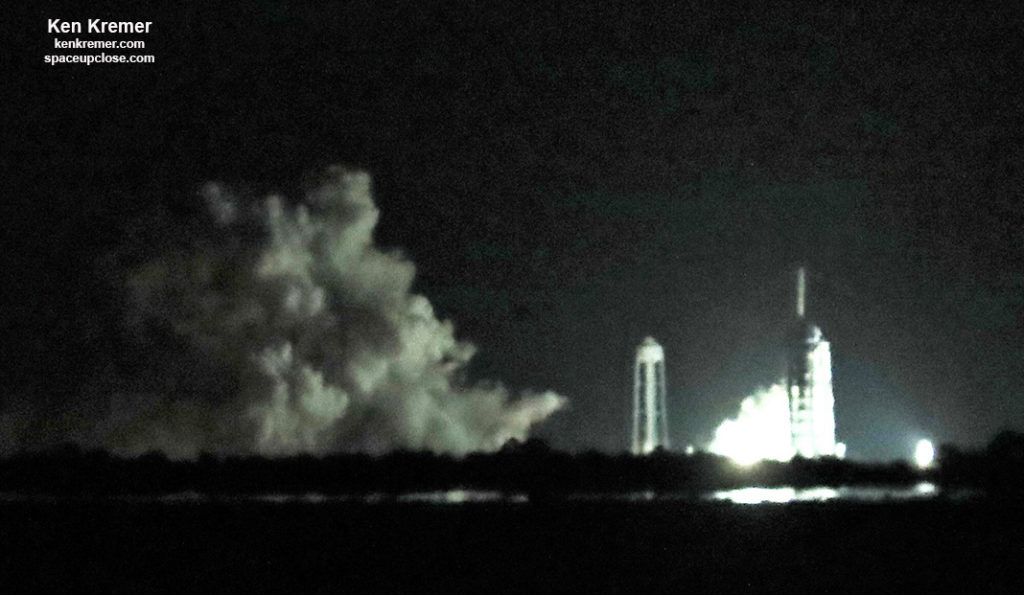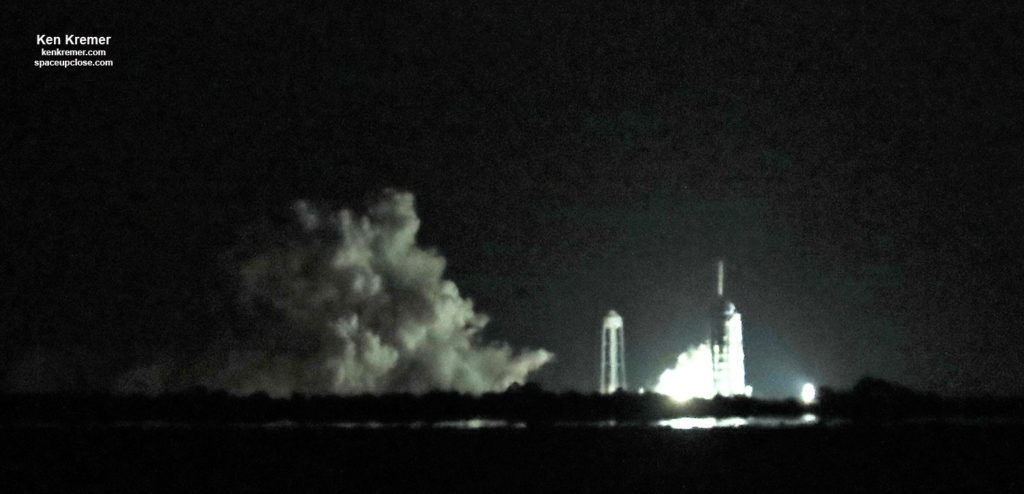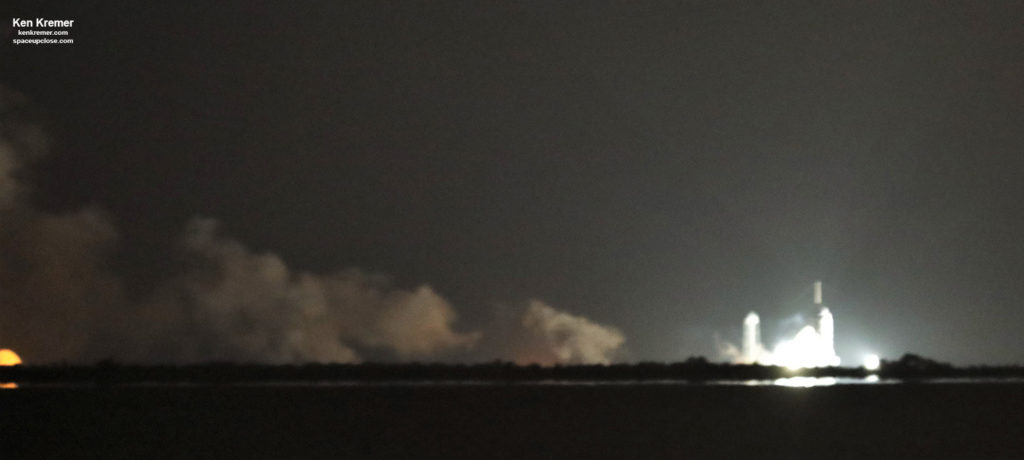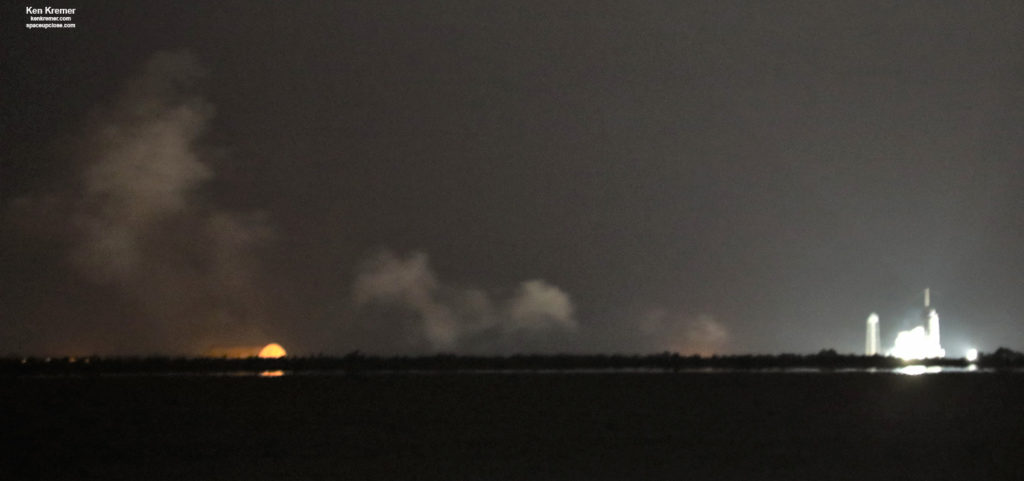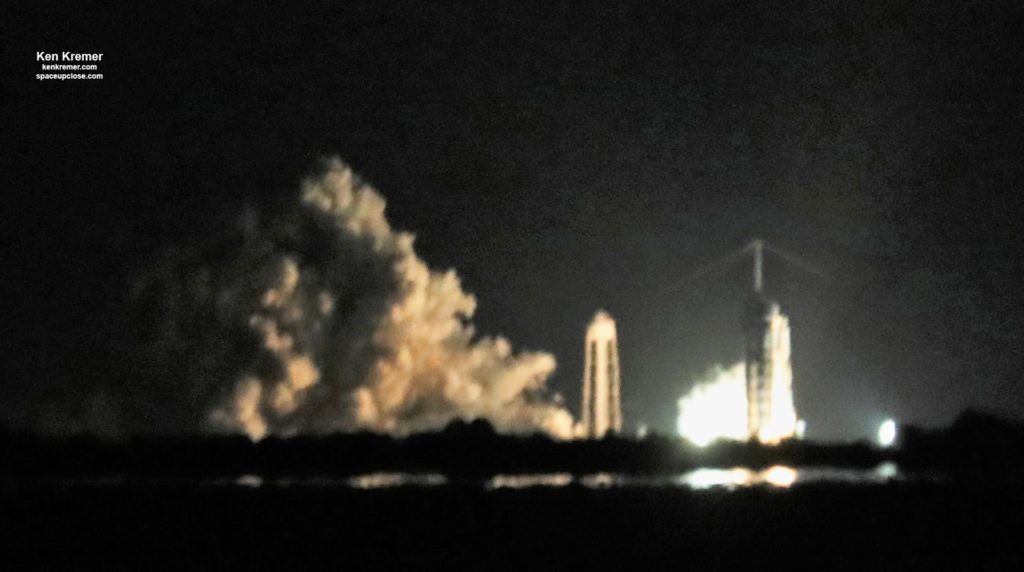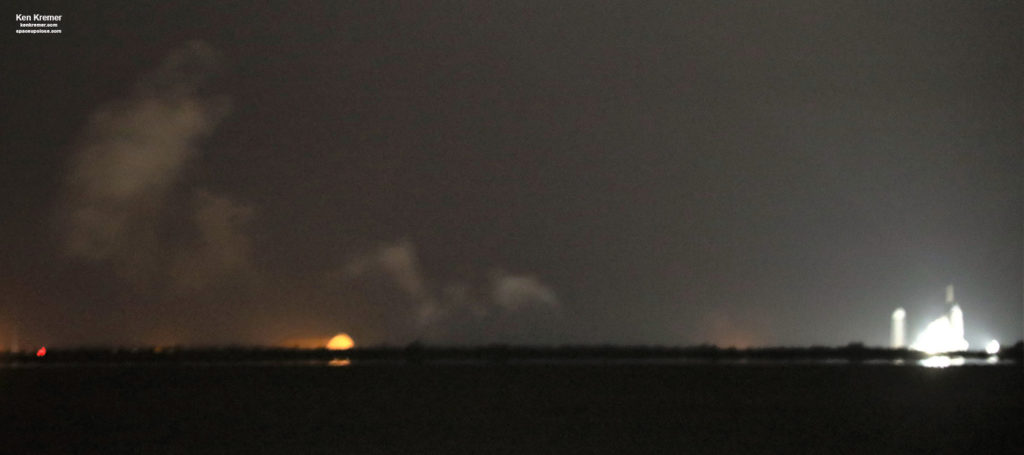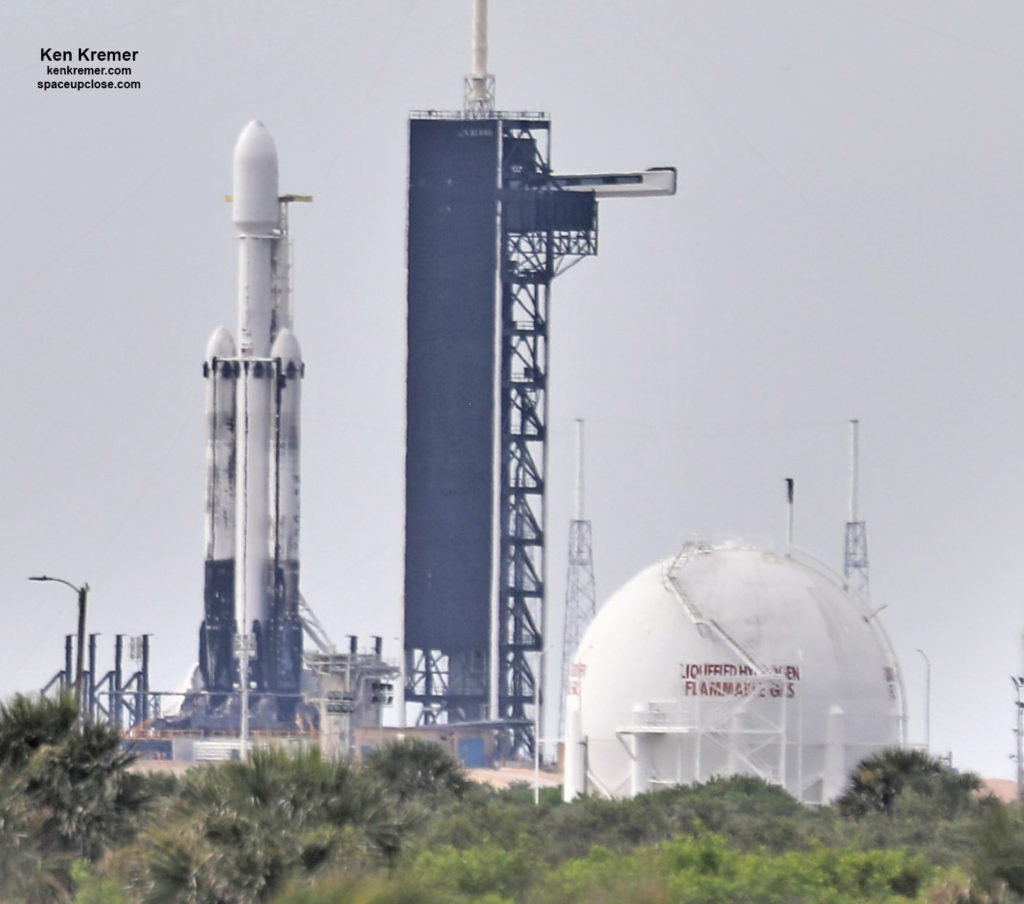Ken
Kremer — SpaceUpClose.com &
RocketSTEM – 20 June 2019
TITUSVILLE/MERRITT ISLAND NATIONAL WILDLIFE REFUGE, FL – SpaceX engineers successfully completely a critical
hold down nighttime test firing of the worlds most powerful rocket, the mammoth Falcon Heavy, shortly before
midnight Wednesday, June 19 – thereby paving the path for the first ever
nighttime blastoff of the beast generating
5 million pounds of thrust on what is certain to be an absolutely magnificent
spectacle on Florida’s Space Coast Monday evening June 24.
This 3rd launch of the SpaceX Falcon
Heavy marks the 1st ever mission of the triple stick rocket for the
US Air Force. The mission is being conducted in joint partnership with NASA and
NOAA and will deliver two dozen military and science satellites to different
orbits.
liftoff after engineers prepared the gigantic rocket for the requisite static
fire test to confirm its readiness for launch.
Liftoff of the Space Test Program-2
(STP-2) mission paid for by the Department
of Defense (DoD) and managed by the U.S Air Force Space
and Missile Systems Center (SMC) is now targeted for launch on June 24, 2019 at 11:30 p.m. EDT from
Launch Complex 39A at the Kennedy Space Center in Florida – following the good
outcome of the hold down static fire test.
Enjoy our Space UpClose photos of the static fire test of
the triple core Falcon Heavy rocket captured late Wednesday night, June 19,
just before midnight after the test delaying awful weather subsided.
Check back as the gallery grows.
The Air Force is paying for this Falcon Heavy
mission launch and using it to certify the rocket for future launches of US
National Security missions, including use of reused booster hardware.
SpaceX will attempt to recover all 3 cores by land and by
sea.
The two side boosters will land back at the Cape 8 minutes
after launch and the center core will touchdown at sea on the OCISLY droneship.
The brief test firing finally took place at
days end after being delayed multiple times throughout the day, unsurprisingly,
as the team worked through significant pad operations and after awful stormy weather
dashed plans to carry it out mid afternoon.
Torrential downpours, strong gusty winds and
rainstorms battered and inundated the Cape Canaveral region throughout the afternoon
and early evening.
The static fire test of the 27 Merlin 1D first stage engines
was completed late Wednesday evening at about 11:32 p.m. EDT in darkness and
difficult to see – as I watched first hand from across the Banana River some 12
miles away.
This spot was much further away than the National Wildlife
Refuge which would have taken place in broad daylight and been easily visible – from where I was stationed in the afternoon.
The National park closes at 8 p.m.
Nevertheless I had a good view to see first the pretest venting, which was extensive lasting more than 20 minutes, and then the short duration
engine test.
I observed a vast vapor plume erupting from the rockets
base at last at 11:32 p.m.
SpaceX confirmed a good test over an hour later by tweet:
“Static
fire of Falcon Heavy complete—targeting June 24 launch of STP-2 from Launch
Complex 39A in Florida.”
seconds generating
some 5 million pounds of thrust – with the rocket erected at pad 39A while the
two stage rocket was restrained on the pad – including with a payload fairing
attached that likely was only a test fairing minus the actual satellites.
During Wednesday night’s
hold down static fire test, the rocket’s first and second stages are fueled with
liquid oxygen and RP-1 propellants just like an actual launch, and a simulated
countdown was carried out to the point of a brief engine ignition – usually in the range of about 3 to 12 seconds
or so.
Under the dark
nighttime pad conditions it was difficult to determine the test duration.
However it
seemed to be on the longer side closer to 6 to 10 seconds or more based on the very
long extent of the horizontal exhaust plume that took longer than normal to
dissipate.
I did not hear
the rockets engines ruble several seconds later as the vapor cloud dissipated.
The pad team rolled the 23-story tall rocket out from the
hangar and up the ramp to the top of Launch Complex
39A. They raised the rocket at dawn in the 6 a.m. hour on Wednesday. The
erection took about 30 minutes.
The 3700 kg payload of 24 satellites and the payload fairing
apparently were not actually attached to the rocket for the hold down test –
rather it was a “non-flight” unit used for acoustic testing at the request of
the Air Force – says Spaceflight Now.
The launch window opens at 11:30 p.m. EDT and extends four
hours to 3:30 a.m. June 25.
The weather is currently 70% GO.
In case of any delay the next launch opportunity is
Tuesday, June 25 with the same launch window.
This Falcon Heavy blastoff is sure to be spectacular being
the first nighttime launch of the triple stick rocket.
It will also feature the first double nighttime landing of
the two side boosters back at the Cape at Landing Zone-1 (LZ-1).
Massive crowds of spectators are expected and already arriving
from around the world.
to space on the first ever mission for the DOD that also includes four
satellites for NASA and more for NOAA, a number of Universities, Industry and one for the Planetary Society.
inclinations as the second stage is fired for a record 4 separate times in
another test of its capabilities.
investigating technologies that will help improve future spacecraft design and
performance in space.
Space Test Program-2 flight include:
interplanetary navigation that could change how we
navigate on the Moon, to Mars and beyond,
weather affects spacecraft hardware,
beyond what it is today, and
to study irregularities in Earth’s upper atmosphere that interfere with GPS and
communications signals.
sponsoring the Constellation Observing System for Meteorology Ionosphere &
Climate-2, or COSMIC-2 system – a constellation of 6 satellites.
The STP-2 mission will be among the most challenging
launches in SpaceX history with four separate upper-stage engine burns, three
separate deployment orbits, a final propulsive passivation maneuver and a total
mission duration of over six hours,” SpaceX says.
addition, the U.S. Air Force plans to reuse side boosters from the Arabsat-6A
Falcon Heavy launch, recovered after a return to launch site landing, making it
the first reused Falcon Heavy ever flown for the U.S. Air Force.”
three Falcon 9 cores. The center core is new and plumbed differently from the twin
pair of side cores – which are recycled from the Arabsat 6A launch in mid-
April.
tall and 39.9 feet (12.6 m) wide with a mass of 3,125,735 lb
(1,420,788 kg).
launch at News 6 Orlando here:
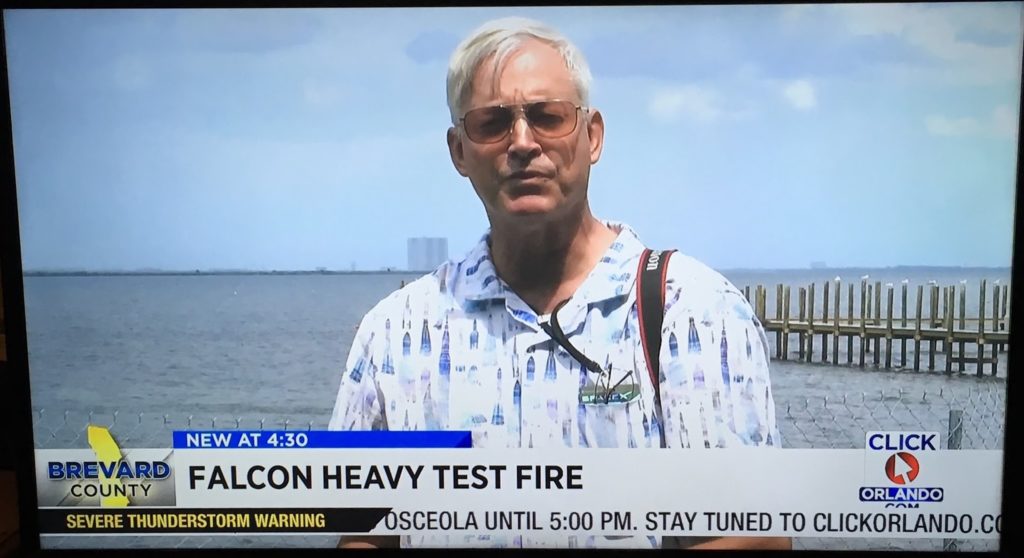 |
|
Dr. Ken
Kremer/Space UpClose interviewed by CBS 6 Orlando TV News WKMG on June 19, 2019 about the Falcon Heavy STP-2 launch targeted for June 24. Credit: CBS 6 WKMG/Ken Kremer screenshot |
for live coverage of the SpaceX Falcon Heavy STP-2 launch.
onsite coverage of NASA, SpaceX, ULA, Boeing, Lockheed Martin, Northrop Grumman
and more space and mission reports direct from the Kennedy Space Center, Cape
Canaveral Air Force Station, Florida and Wallops Flight Facility, Virginia.
Stay tuned here for Ken’s continuing Earth and
Planetary science and human spaceflight news: www.kenkremer.com –www.spaceupclose.com – twitter @ken_kremer
– email: ken at kenkremer.com
Dr. Kremer is a research scientist and journalist based in the
KSC area, active in outreach and interviewed regularly on TV and radio about
space topics.
………….
Ken’s photos are for sale and he is available for lectures and outreach events
Ken’s upcoming outreach events:
Jun 22-24: Quality Inn Kennedy Space Center, Titusville,
FL, evenings. Learn more about the upcoming/recent Falcon Heavy, NASA 2024 Moon landing
goal, SpaceX Starlink-1, SpaceX Falcon 9/CRS-17
launch to ISS, SpaceX Demo-1 launch/test failure, SpaceX Beresheet launch, NASA missions, ULA Atlas & Delta launches,
Northrop Grumman Antares, SpySats and more


